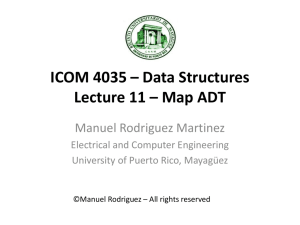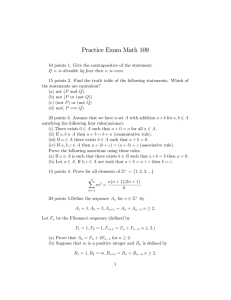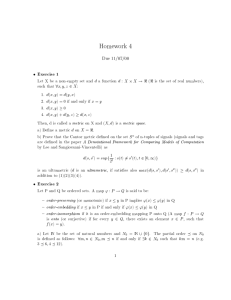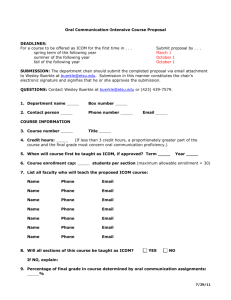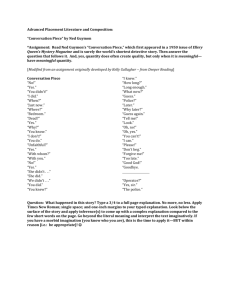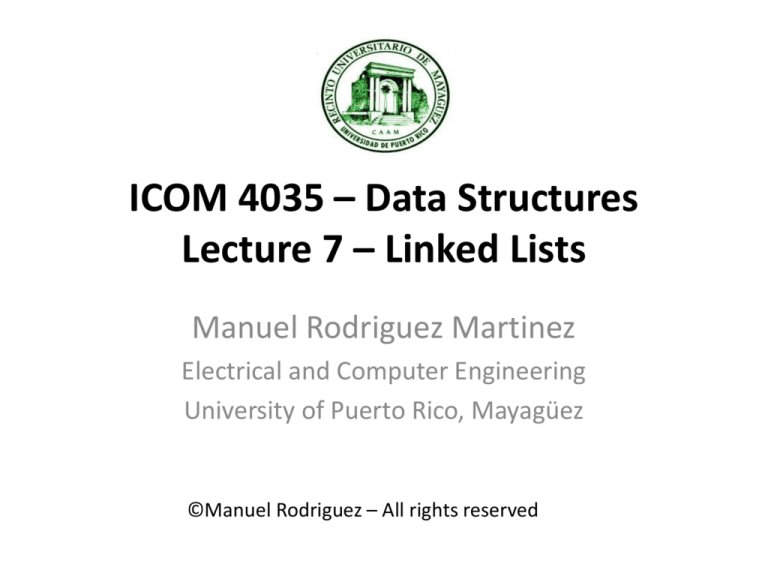
ICOM 4035 – Data Structures
Lecture 7 – Linked Lists
Manuel Rodriguez Martinez
Electrical and Computer Engineering
University of Puerto Rico, Mayagüez
©Manuel Rodriguez – All rights reserved
Lecture Organization
• Part I – Introduction to the linked list data
structure
• Part II – Design and implementation of linked
list data structure
• Part III – Iterating over a linked list
M. Rodriguez-Martinez
ICOM 4035
2
Objectives
• Introduce the concept of linked list
– List with fully dynamically allocated space
• Discuss the advantages/disadvantages with
respect to ArrayList
• Understand the design and implementation of
the linked list as a method to realize List ADT
• Provide motivating examples
M. Rodriguez-Martinez
ICOM 4035
3
Companion videos
• Lecture7 videos
– Contains the coding process associated with this
lecture
– Shows how to build the interfaces, concrete
classes, and factory classes mentioned here
M. Rodriguez-Martinez
ICOM 4035
4
Part I
• Introduction to the linked list data structure
M. Rodriguez-Martinez
ICOM 4035
5
List ADT
• List:
– collection of things with notion of assigned position
• Order is given by position in list
• Element x is at position 0, element y is at position 1
– repetitions are allowed
– Mathematical term: finite sequence
Ron
Toyota
Jil
BMW
Ron
Ford
Ned
Empty list
M. Rodriguez-Martinez
List with names
ICOM 4035
List with car brands
6
ArrayList Implementation
• Allocate a contiguous
block of memory
Fields
3 2 3 1 9
– Need idea of initial capacity
• Store elements in this
region
• Random access to
elements at position i
5
elements
ArrayList
currentSize
Methods
– L.get(i), L.set(i) are O(1)
• But, when full need to
reallocate space
3 2 3 1 9
co
contiguous
– Inefficient!
M. Rodriguez-Martinez
RAM
ICOM 4035
7
Linked List Data Structure
a node
header
Æ
Apu
Ned
Ron
Ron
• Fully dynamic structure
• Add extra space as needed to accommodate new values
null
– No need to reallocate and copy
• Elements are chained together in sequence
• Each entry is called a node, and stores:
– Value
– Reference to next node in the chain
• Header – points to the start of chain and stores no value
– Called “dummy header”, its stored value is set to null
• Last element has a next reference set to null (shown with ground
symbol)
M. Rodriguez-Martinez
ICOM 4035
8
Structure of linked list node
value stored
in node
Apu
Arrow denotes reference
to next node
Reference to
next node
in chain
Jil
Apu
...
...
Chaining of nodes
M. Rodriguez-Martinez
ICOM 4035
9
Linked List Class
Fields
header
Æ
Apu
Ned
Ron
Ron
currentSize 4
Methods
• Linked list class has two fields
– header
– current Size
M. Rodriguez-Martinez
ICOM 4035
10
Linked List Examples
header
Empty List
One-element List
Æ
header
Æ
Ron
Two-element List
header
Æ
Ned
Ron
Multi-element List
header
M. Rodriguez-Martinez
Æ
Apu
Ned
ICOM 4035
Ron
Ron
11
List ADT and Linked List
Apu
0
1
2
3
4-element list
Ned
Ron
Ron
4-element list implemented with a linked list
header
M. Rodriguez-Martinez
Æ
Apu
Ned
Ron
Ron
0
1
2
3
ICOM 4035
12
Features of Linked List
• Support for all List ADT operations
• Small memory footprint
– Nodes are allocated as needed
• No limit to capacity (other than RAM size)
• No need to reallocate or copy elements
• Multiple variations:
– Singly-linked list - nodes point to next
• the one we saw earlier
– Doubly-linked list - nodes point to next & previous
– Circular Doubly-linked list - nodes form a circular chain
M. Rodriguez-Martinez
ICOM 4035
13
Part II
• Design and implementation of liked list data
structure
M. Rodriguez-Martinez
ICOM 4035
14
Design of ListADT
ArrayList
LinkedList
<<interface>>
List
M. Rodriguez-Martinez
ICOM 4035
15
Operations on the List
• Supported:
–
–
–
–
–
Add new element at the end
Add new element at position i
Remove a copy of an element
Remove element at position i
Remove all copies of an
element
– Clear List
– Test for element membership
– Get List size
M. Rodriguez-Martinez
ICOM 4035
–
–
–
–
–
–
–
–
Get first element in List
Get last element in List
Get element at position i
Set element at position i
Get first index of element x
Get last index of element x
Test if empty
Iterate over all stored
values
16
Add new element
• Adding Apu to List L
– Append to the end of list
• Add a new node to the end of list
0
1
2
3
4
Jil
Ned
Moe
M. Rodriguez-Martinez
L.add(“Apu”);
ICOM 4035
0
1
2
3
4
Jil
Ned
Moe
Apu
17
Add new element (2)
current size: 3
header
header
Æ
Æ
Jil
Ned
Moe
0
1
2
Jil
Ned
Moe
0
1
2
L.add(“Apu”);
Now make
new node last
element
Apu
current size: 4
Create a new node
with Apu as its value
M. Rodriguez-Martinez
ICOM 4035
18
Add new element (3)
Resulting list
header
current size: 4
Æ
Jil
Ned
Moe
Apu
0
1
2
3
• Key idea: Go to end of list and add new node
– End of list is node with next reference set to null
– Increment currentSize
• Operation is O(n), n = length of list
– Can be made O(1) by having dummy tail
• Points to last element
M. Rodriguez-Martinez
ICOM 4035
19
Add new element at position i
• Adding Mel to List L at position 1
– Moves everyone one position down
– Valid insert positions are [0, currentSize];
• Inserting at currentSize is the add() operation (“append”)
• Add new node at position i in the chain
0
1
2
3
4
Jil
Ned
Moe
M. Rodriguez-Martinez
L.add(1, “Mel”);
ICOM 4035
0
1
2
3
4
Jil
Mel
Ned
Moe
20
Add new element at position i (2)
header
Æ
current size: 3
header
Æ
current size: 4
Now make new node
Element at position 1
M. Rodriguez-Martinez
Jil
Ned
Moe
0
1
2
Jil
Ned
Moe
0
1
2
L.add(1, “Mel”);
Mel
Create a new node
with Mel as its value
ICOM 4035
21
Add new element at position I (3)
Resulting list
header
current size: 4
Æ
Jil
Mel
Ned
Moe
0
1
2
3
• Key idea:
–
–
–
–
–
Go to element at position i-1
Insert new node as its successor
Make new node success be the successor of element i-1
Increment current size
Need to consider two special cases
• Insert at 0 (no element before it)
• Insert at currentSize (call add())
• Operation is O(n), n = length of list
M. Rodriguez-Martinez
ICOM 4035
22
Remove an element
• Remove Ned from List L
– First find first copy
– Move successors one spot ahead in the list
• Keeps relative order
– Special case: erase last one (no successors)
0
1
2
3
4
Jil
Ned
Moe
L.remove(“Ned”);
Apu
M. Rodriguez-Martinez
ICOM 4035
0
1
2
3
4
Jil
Moe
Apu
23
Remove an element (2)
header
Æ
current size: 3
header
current size: 2
Æ
Jil
Ned
Moe
0
1
2
Jil
Ned
Moe
0
1
2
First find the predeccesor
of “Ned” which is “Jil”
L.remove(“Ned”);
Now, deviate next to point to
successor of “Ned” which is Moe
Finally set target to null
M. Rodriguez-Martinez
ICOM 4035
24
Remove an element (3)
Resulting list
header
Æ
Jil
Moe
0
1
• Key idea:
–
–
–
–
–
Go to node that is predecessor of target
Set next of predecessor become the next of target
Set value at target and target itself to null
Decrement current size
Note: Removing first element has header has predecessor
• Operation is O(n), n = length of list
M. Rodriguez-Martinez
ICOM 4035
25
Remove element at position i
• Remove element at position 2
– Position must be in range [0, currentSize-1]
– Move successors one spot ahead in the list
• Keeps relative order
– Special case: erase last one (no successors)
0
1
2
3
4
Jil
Ned
Moe
L.remove(2);
Apu
M. Rodriguez-Martinez
ICOM 4035
0
1
2
3
4
Jil
Ned
Apu
26
Remove an element (2)
L.remove(“2”);
header
header
Æ
Æ
Jil
Ned
Apu
Moe
0
1
2
3
Jil
Ned
Apu
Moe
0
1
2
3
First find the predeccesor
of 2 which is 1
Now, deviate next to point to
successor of 2 which is 3
Finally set target to null
M. Rodriguez-Martinez
ICOM 4035
27
Remove an element (3)
Resulting list
header
Æ
Jil
Ned
Moe
0
1
2
• Key idea:
–
–
–
–
–
Go to node that is predecessor of target
Set next of predecessor become the next of target
Set value at target and target itself to null
Decrement current size
Note: Removing element at 0 has header has predecessor
• Operation is O(n), n = length of list
M. Rodriguez-Martinez
ICOM 4035
28
Remove all copies of an element
• Remove all copies of Ned from List L
– Simply loop calling erase on element
– Complexity is O(n2)
• Can be made O(n)! Think about it!
0
1
2
3
4
Jil
Ned
Moe
L.removeAll(“Ned”);
Ned
M. Rodriguez-Martinez
ICOM 4035
0
1
2
3
4
Jil
Moe
29
Clear list
• Remove all elements from List
– Simply loop erasing element at position 0
– Set currentSize to 0
– Complexity is O(n)
• Why? Think about it
0
1
2
3
4
Jil
Ned
Moe
L.clear();
Ned
M. Rodriguez-Martinez
ICOM 4035
0
1
2
3
4
30
Membership Test
• Determine if element e is in the List
• Simply loop until element is found (if it is there)
• Complexity is O(n), n = L.size()
0
1
2
3
4
Jil
Ned
Moe
L.contains(“Amy”);
Apu
M. Rodriguez-Martinez
ICOM 4035
False
31
Memberships Test
Element found at position 2
L.contains(“Apu”);
header
Æ
currentSize: 4
Jil
Ned
Apu
Moe
0
1
2
3
L.contains(“Amy”);
header
Æ
currentSize: 4
Jil
0
Ned
1
Apu
Moe
2
3
Element not found
M. Rodriguez-Martinez
ICOM 4035
32
First index of element
• Find position of first copy
– Return -1 if not in List
• Loop from start until element is found (if it is there)
– Stop when first copy is found and return its position within the
array
• Complexity: O(n), n = L.size()
0
1
2
3
4
Jil
Ned
Moe
L.firstIndex(“Ned”);
Ned
1
-1
M. Rodriguez-Martinez
ICOM 4035
33
Last index of element
• Find position of last copy
– Return -1 if not in List
• Loop from start to end, save position of element each time
is found (if it is there)
– At the end of loop, return the last position you saw
• Complexity: O(n), n = L.size();
0
1
2
3
4
Jil
Ned
Moe
L.lastIndex(“Ned”);
Ned
3
-1
M. Rodriguez-Martinez
ICOM 4035
34
Get element at position i
• Determine if position i is valid in the List
– Must be in range [0, currentSize-1]
• Get the value of element[i]
– Traverse the list until you reach position I
– Return the value at that node
• Complexity: O(n), n = L.size()
– Linear access (ArrayList was O(1))
0
1
2
3
4
Jil
Ned
Moe
Apu
M. Rodriguez-Martinez
L.get(1);
Ned
L.get(0);
L.get(5);
Jil
Invalid
ICOM 4035
35
Set element at position i
• Determine if position i is valid in the List
– Must be in range [0, currentSize-1]
• Change the value of element[i]
– Traverse the list until you reach position i
– Replace value field of node at position i
– Does not change the size of the List (it is a replacement)
• Different from add() at position I
• Complexity: O(n), n = L.size() (ArrayList was O(1))
0
1
2
3
4
Jil
Ned
L.set(1, “Amy”);
Moe
Apu
M. Rodriguez-Martinez
ICOM 4035
0
1
2
3
4
Jil
Amy
Moe
Apu
36
Easy operations
• List size
– Return currentSize
• Empty list
– Check if list size is equal to 0
M. Rodriguez-Martinez
ICOM 4035
37
Part III
• Iterating over List elements
M. Rodriguez-Martinez
ICOM 4035
38
Iterating over List elements
• We want to iterate over elements inside list
– To use them for whatever reason we need them
• Done by making List iterable
– List interface extends Java Iterable interface
– Enables List to return an iterator
• How do we do this?
– Need to have an inner class that helps you iterate
over List elements
• ListIterator class that implements Java Iterator interface
M. Rodriguez-Martinez
ICOM 4035
39
List iterator
• Inner class with one field: reference to next node
to visit in iteration
ListIterator
nextNode
Fields
header
Æ
Apu
Ned
currentSize 4
Ron
Ron
LinkedList
Methods
M. Rodriguez-Martinez
ICOM 4035
40
List Iterator
• delete:
– unsupported
• hasNext:
– Test if nextNode is null
• next:
– If hasNext
• return value at node
• Set nextNode to be equal to nextNode.getNext()
M. Rodriguez-Martinez
ICOM 4035
41
Summary
• Linked List
– Fully dynamic structure
• Allocates space as needed, no need to reallocate space
• Singly linked list
– Each node points to next element in the chain
• Tradeoff
– Add, get, and set are slower
– No need to re-allocate
– Small memory footprint
M. Rodriguez-Martinez
ICOM 4035
42
Questions?
• Email:
– manuel.rodriguez7@upr.edu
M. Rodriguez-Martinez
ICOM 4035
43

